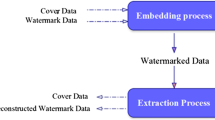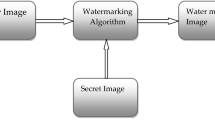Abstract
Digital watermarking can be used as data hiding technique to interleave cover content with auxiliary information before transmitting and storing applications. While image and video watermarking has been widely studied, much less attention has been paid to its application in 3D mesh models. This is principally due to their intrinsic irregular sampling nature. This paper proposes a high-capacity watermarking scheme for the purpose of inserting meta-data into 3D triangle meshes. Our proposal can be applied to meshes with arbitrary topology by using irregular wavelet-based analysis. The watermark is embedded in an appropriate resolution level by quantizing the norms of wavelet coefficient vectors. To ensure robustness to similarity transformation, a robust synchronization (indexing) mechanism is performed on the 3D model after irregular wavelet analysis. Experimental results show that our watermarking framework is robust to common geometric attacks and can provide relatively high data embedding rate whereas keep a relative lower distortion.




Similar content being viewed by others
References
Cox IJ, Miller ML, Bloom JA, Fridrich J., Kalker T (2007) Digital watermarking and steganography. Morgan Kaufmann Publishers Inc. ISBN: 978-0-12-372585-1
Wang Z, Bovik A, Sheikh H, Simoncelli E (2004) Image quality assessment: from error visibility to structural similarity. Proc IEEE Trans Image Process 13 (4):1–14
Lavoué G, Gelasca ED, Dupont F, Baskurt A, Ebrahimi T (2006) Perceptually driven 3D distance metrics with application to watermarking. Proc SPIE Electron Imaging 6312
Lounsbery M, DeRose TD, Warren J (1997) Multiresolution analysis for surfaces of arbitrary topological type. ACM Trans Graph 16:34–37
Lin CH, Chao MW, Chen JY, Yu CW, Hsu WY (2013) A high-capacity distortion- free information hiding algorithm for 3D polygon models. Int J Innov Comput Inf Control 9 (3):1321–1335
Gao X, Zhang C, Huang Y, Deng Z (2012) Multiresolution analysis for surfaces of arbitrary topological type. ACM Trans Multimed Comput Commun Appl 8
Lee H, Dikici C, Lavoué G, Dupont F (2012) Joint reversible watermarking and progressive compression of 3D meshes. Appl Math Comput 27 (6-8):781–792
Ai QS, Liu Q, Zhou ZD, Yang L, Xie SQ (2009) A new digital watermarking scheme for 3D triangular mesh models. Signal Process 89:2159–2170
Chung IL, Chou CM, Tseng DC (2011) A robust high capacity affine-transformation-invariant scheme for watermarking 3D geometric models. Proc J Innov Comput Inf Control 7 (6):3419–3435
Bogomjakov A, Gotsman C, Isenburg M (2008) Distortion-free steganography for polygonal meshes. Proc Comput Graph Forum 27 (2):637–642
Cheng YM, Wang CM (2006) A high-capacity steganographic approach for 3D polygonal meshes. Int J Comput Graph 22 (9):845–855
Wang CM, Cheng YM (2005) An efficient information hiding algorithm for polygon models. Comput Graph Forum 24 (3):591–600
Wang CM, Cheng YM (2006) Watermarking mesh-based representations of 3-D objects using local moments. IEEE Trans Image Process 15 (3):687–701
Maret Y, Ebrahimi T (2004) Data hiding on (3D) polygonal meshs. In: Proceedings of ACM multimedia and security workshop. Magdeburg, Germany pp. 68–74
Costa M (1983) Writing on dirty paper. IEEE Trans Inf Theory 29 (3):439–441
Cayre F, Macq B (2003) Data hiding on (3-D) triangle meshs. IEEE Trans Signal Process 51 (4):939–949
Chen B, Wornell GW (2001) Quantization index modulation, a class of provably good methods for digital watermarking and information embedding. IEEE Trans Inf Theory 47 (4):1423–1443
Valette S, Prost R (2004) Multiresolution analysis of irregular surface meshes. IEEE Trans Vis Comput Graph 10:113–122
Kim MS, Valette S, Jung HY, Prost R (2005) Watermarking of 3D irregular meshes based on wavelet multiresolution analysis. Proc Int Work Digit Watermarking (IWDW’05):313–324
Uccheddu F, Corsini M, Barni M (2004) Wavelet-based blind watermarking of 3D models. In: Proceedings of workshop on multimedia and security. ACM Press, pp 143–154
Kanai S, Date H, Kishinami T (1998) Digital watermarking for 3D polygon using multiresolution wavelet decomposition. In: Proceedings of sixth IFIP WG 5.2 GEO-6. Tokyo, pp 296–307
Wang K, Lavoué G, Denis F, Baskurt A (2008) Hierarchical watermarking of semiregular meshes based on wavelet transform. IEEE Trans inf Forensic Secur 3:620–634
Yang S, Yao Z (2010) A data hiding scheme based on local coordinate system for 3D triangle mesh models. J Softw 5 (4):437–446
Sweldens W (1998) The lifting scheme: a construction of second generation wavelets. SIAM J Math Anal 29 (2):511–546
Chen L, Kong X, Weng B, Yao Z, Pan R (2011) A novel robust mesh watermarking based on BNBW. EURASIP J Adv Signal Process
Wang K, Lavoué G, Denis F, Baskurt A (2008) A comprehensive survey on three-dimensional mesh watermarking. Proc IEEE Trans Multimed 10 (8):1513–1527
Alface RP, Macq B (2007) From 3D mesh data hiding to 3D shape blind and robust watermarking: A survey. Lect Notes Comput Sci Trans Data Hiding Multimed Syst 2:99–115
Aspert N, Santa-Cruz D, Ebrahimi T (2002) Mesh: measuring errors between surfaces using the Hausdorff distance
Author information
Authors and Affiliations
Corresponding author
Rights and permissions
About this article
Cite this article
Zaid, A.O., Hachani, M. & Puech, W. Wavelet-based high-capacity watermarking of 3-D irregular meshes. Multimed Tools Appl 74, 5897–5915 (2015). https://doi.org/10.1007/s11042-014-1896-3
Published:
Issue Date:
DOI: https://doi.org/10.1007/s11042-014-1896-3




